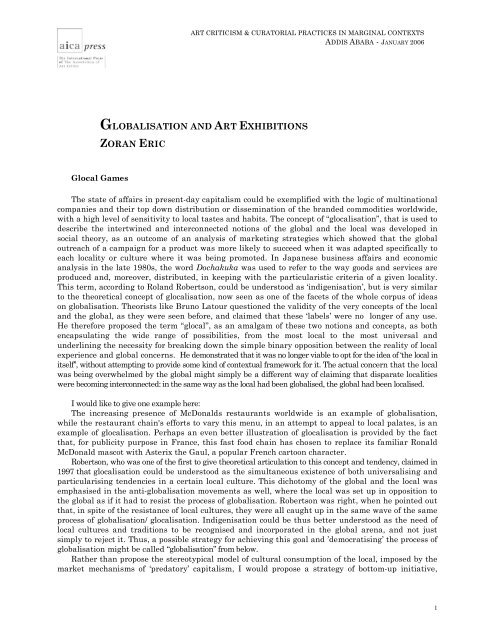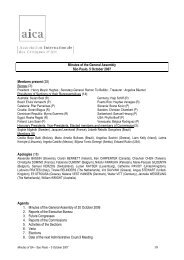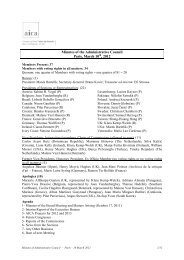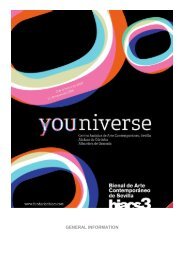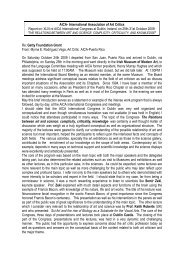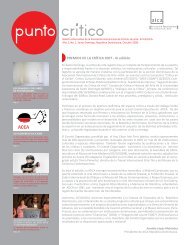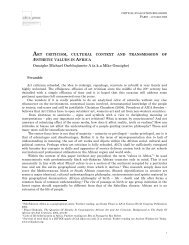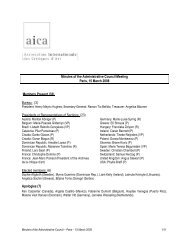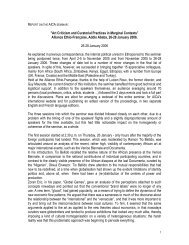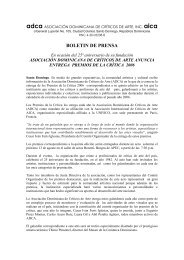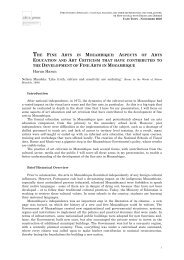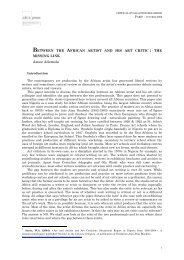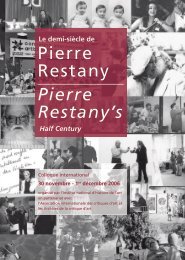Zoran ERIC - Globalization and Art Exhibitions - AICA international
Zoran ERIC - Globalization and Art Exhibitions - AICA international
Zoran ERIC - Globalization and Art Exhibitions - AICA international
You also want an ePaper? Increase the reach of your titles
YUMPU automatically turns print PDFs into web optimized ePapers that Google loves.
ART CRITICISM & CURATORIAL PRACTICES IN MARGINAL CONTEXTSADDIS ABABA - JANUARY 2006GLOBALISATION AND ART EXHIBITIONSZORAN <strong>ERIC</strong>Glocal GamesThe state of affairs in present-day capitalism could be exemplified with the logic of multinationalcompanies <strong>and</strong> their top down distribution or dissemination of the br<strong>and</strong>ed commodities worldwide,with a high level of sensitivity to local tastes <strong>and</strong> habits. The concept of “glocalisation”, that is used todescribe the intertwined <strong>and</strong> interconnected notions of the global <strong>and</strong> the local was developed insocial theory, as an outcome of an analysis of marketing strategies which showed that the globaloutreach of a campaign for a product was more likely to succeed when it was adapted specifically toeach locality or culture where it was being promoted. In Japanese business affairs <strong>and</strong> economicanalysis in the late 1980s, the word Dochakuka was used to refer to the way goods <strong>and</strong> services areproduced <strong>and</strong>, moreover, distributed, in keeping with the particularistic criteria of a given locality.This term, according to Rol<strong>and</strong> Robertson, could be understood as ‘indigenisation’, but is very similarto the theoretical concept of glocalisation, now seen as one of the facets of the whole corpus of ideason globalisation. Theorists like Bruno Latour questioned the validity of the very concepts of the local<strong>and</strong> the global, as they were seen before, <strong>and</strong> claimed that these ‘labels’ were no longer of any use.He therefore proposed the term “glocal”, as an amalgam of these two notions <strong>and</strong> concepts, as bothencapsulating the wide range of possibilities, from the most local to the most universal <strong>and</strong>underlining the necessity for breaking down the simple binary opposition between the reality of localexperience <strong>and</strong> global concerns. He demonstrated that it was no longer viable to opt for the idea of ‘the local initself’’, without attempting to provide some kind of contextual framework for it. The actual concern that the localwas being overwhelmed by the global might simply be a different way of claiming that disparate localitieswere becoming interconnected: in the same way as the local had been globalised, the global had been localised.I would like to give one example here:The increasing presence of McDonalds restaurants worldwide is an example of globalisation,while the restaurant chain's efforts to vary this menu, in an attempt to appeal to local palates, is anexample of glocalisation. Perhaps an even better illustration of glocalisation is provided by the factthat, for publicity purpose in France, this fast food chain has chosen to replace its familiar RonaldMcDonald mascot with Asterix the Gaul, a popular French cartoon character.Robertson, who was one of the first to give theoretical articulation to this concept <strong>and</strong> tendency, claimed in1997 that glocalisation could be understood as the simultaneous existence of both universalising <strong>and</strong>particularising tendencies in a certain local culture. This dichotomy of the global <strong>and</strong> the local wasemphasised in the anti-globalisation movements as well, where the local was set up in opposition tothe global as if it had to resist the process of globalisation. Robertson was right, when he pointed outthat, in spite of the resistance of local cultures, they were all caught up in the same wave of the sameprocess of globalisation/ glocalisation. Indigenisation could be thus better understood as the need oflocal cultures <strong>and</strong> traditions to be recognised <strong>and</strong> incorporated in the global arena, <strong>and</strong> not justsimply to reject it. Thus, a possible strategy for achieving this goal <strong>and</strong> ’democratising’ the process ofglobalisation might be called “globalisation” from below.Rather than propose the stereotypical model of cultural consumption of the local, imposed by themarket mechanisms of ‘predatory’ capitalism, I would propose a strategy of bottom-up initiative,1
ART CRITICISM & CURATORIAL PRACTICES IN MARGINAL CONTEXTSADDIS ABABA - JANUARY 2006based on a variety of local case studies. I would like to analyse how images, meanings <strong>and</strong> valuesassociated with specific localities are generated <strong>and</strong> circulate within the global cultural economy.Global FlowsAnother way of looking at the same problem would be to analyse the process of globalisationthrough the tensions between cultural homogenisation <strong>and</strong> heterogenisation that is, for ArjunAppadurai, the central problem of today's global interactions. But what actually quite often happensis that homogenisation is regarded as synonymous with Americanisation or commodification, <strong>and</strong>consequently the later two arguments are closely connected. Here, the basic element omitted fromthe account is the fact that, no matter how fast the impulses from various metropolises areintroduced into different local societies, they themselves soon enough become indigenised.Here, we would do well to take note of the fact that the present model of disorganised capitalismis creating a new, multifaceted, intertwined, disjunctive order within the global cultural economy.This resists falling into the category of a binary oppositional model of the analysis of societalprocesses deriving from various discourses or practices, such as neo-Marxism (consumers vs.producers), or traditional trade (surplus vs. deficit). However, the model cannot any longer beunderstood in terms of an antimony between centre <strong>and</strong> periphery.It has, therefore, become a commonplace, to state that today’s world is principally characterisedby objects in motion. If we were to draw up a spatial flowchart, it would encompass objects, such asideas <strong>and</strong> ideologies, people <strong>and</strong> goods, images <strong>and</strong> messages, <strong>and</strong> technologies <strong>and</strong> techniques.Appadurai proposed the model of “scaping” <strong>and</strong> defined the flow of images, histories <strong>and</strong> informationas “mediascapes”; the flows of cultural <strong>and</strong> political ideologies as “ideoscapes”; finance flows as“financescapes”; <strong>and</strong> flows of migrants, tourists <strong>and</strong> refugees as “ethnoscapes”. Finally, adding to thisanalysis, he introduced us, later on, to the most interesting notion of “artscapes”.Global <strong>Art</strong> <strong>Exhibitions</strong>I will, therefore, now try to shift this rhetoric from social, political <strong>and</strong> economic references to thefield of art references. When it comes to placing products related to art <strong>and</strong> culture in the globalcultural economy, it comes to the point where adding a geopolitically infused “local flavor”' to worksconceived within globally accepted paradigms, adds much more to the prospects of successfullymarketing an art project than any consideration of its conceptual background, or framework ofinternal artistic references.The process of globalisation in the realm of contemporary art has been manifested in theproliferation of biennial exhibitions, disrupting the old geographical hegemonies of the big art centres<strong>and</strong> revealing the multifaceted, disjunctive order of the new global art space. Curators frequentlyturn into globetrotters, competing in global cities, producing discourses for contextualisation <strong>and</strong>developing new formats for artistic display. The side effect of this phenomenon is that many globalbiennials are becoming as alike as if they adopted the logic of multinational companies whichdisseminate their commodities worldwide, always adding a touch of a local flavour to the product, toimprove the prospects of marketing it within a local context. For me, this process is a very goodmetaphor for what is happening with the big <strong>international</strong> biennials. The same “flavour” is to befound anywhere — it just needs to be br<strong>and</strong>ed — <strong>and</strong> linked to the global cultural economy.There is mostly some minor local flavour but these biennials are all, basically, large-scale events,in which the art market has a major presence. No wonder that big art events attract sponsorshipfrom multinational companies. It was not the curator, Dan Cameron, who presided over theinaugural press conference at the opening of the last but one Istanbul Biennial, but a representative2
ART CRITICISM & CURATORIAL PRACTICES IN MARGINAL CONTEXTSADDIS ABABA - JANUARY 2006of a Japanese tobacco company! Of course, there is more to it than that, <strong>and</strong> it is not only the artmarket that initiates big events, like biennials, in different cities around the globe, but there must bea connection with the local structures that are willing to support these biennials.The process described above could be regarded as an example of cultural homogenization, butthen it should be noted that a process of cultural heterogenisation – the acknowledgement of culturaldifferences goes on at the same time. This tendency has a genealogy extending onwards from theexhibition Les Magiciens de la terre, in 1989, to its peak at Documenta 11, in 2002.Here I would note that after the colonising gaze of the Western countries, post-colonial discourse<strong>and</strong> emancipation, we are witnessing the most recent, <strong>and</strong> most sophisticated tendency in the globalcultural economy to explore local ethnicities <strong>and</strong> cultural specificities. The logic of multinationalcompanies that I was describing in the sphere of visual arts is exemplified by the globally understoodrequirements of the art market, that the artistic language, media <strong>and</strong> visual articulation of theartworks conform to recognisable, <strong>and</strong> acceptable, (Western) st<strong>and</strong>ards <strong>and</strong>, still more importantly,that the content, topic <strong>and</strong> subject relate to local ethno-cultural habits <strong>and</strong> tradition, to folklore, <strong>and</strong>to local anthropological distinctiveness.The same phenomena can be observed, not just in the visual arts, but in many culturaldisciplines, such as music (world music), cinema, (viz the boom in small national film industries inthe nineties), through which we can trace a similar exploration of ‘world art’ or, as we might choose tocall it, “ethno-cultural global art”.Does this mean that all local cultures should reproduce the Western art system, foster global artmarket <strong>and</strong> indulge global artistic celebrities? No! On the contrary, as we said before, what could beat stake is a process of grassroots globalisation in the cultural field, <strong>and</strong> the incorporation <strong>and</strong>contextualisation of a variety of different histories of art. We could, therefore, argue that theglobalisation of culture should not be understood merely as homogenisation, but, on the contrary, asthe interrelation between cultural homogenisation <strong>and</strong> cultural heterogenisation, which, as we havenoted, is beginning to emerge as one of the key issues of global interaction, in our time.We should be constantly seeking to demonstrate that the “genealogies” of modern art in differentregions of the world are not necessarily the same as in Western European countries. The history ofart that was in the period of Cold War “normatively” presented to us ‘was almost entirely based onreadings of its development in the Western world, at the price of neglecting the developments in forexample Eastern Europe, or sometimes including them, as marginal offshoots to the prevailingmovements <strong>and</strong> –“isms” of the time. This was reinforced by the “self-marginalising” cultures that didnot try to “produce” their own art history <strong>and</strong> inscribe it into a wider context, as a global asset, buttried to copy the existing models of analyses. Here I would fully agree with the group IRWIN, fromSlovenia, with their “East <strong>Art</strong> Map” project, that the art history of, in their case, East Europe has tobe “produced”, <strong>and</strong> written. For this purpose, we also need to map, document, analyse <strong>and</strong> interpretall the important initiatives emanating from different regions of the world.© <strong>AICA</strong> Press et l’auteur3


